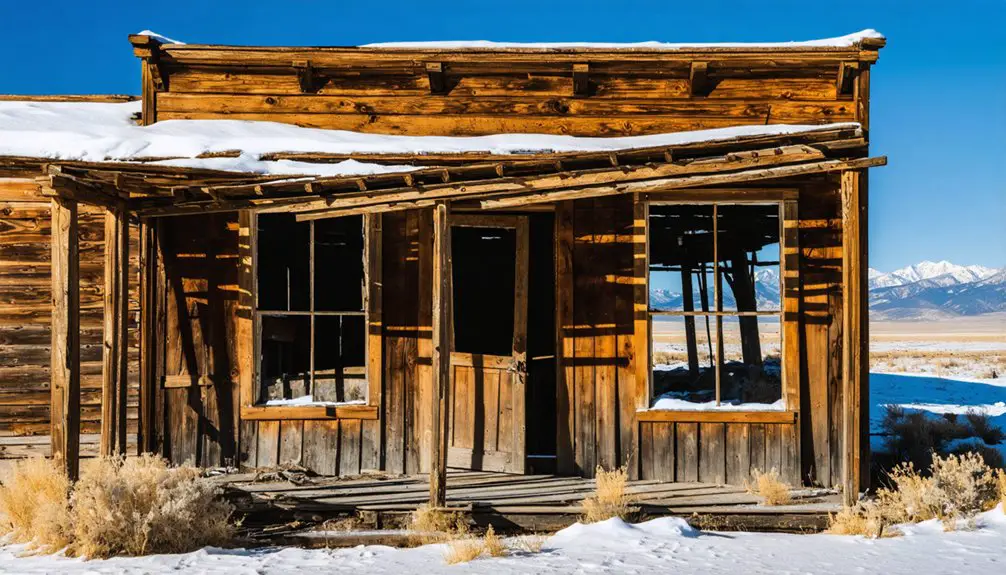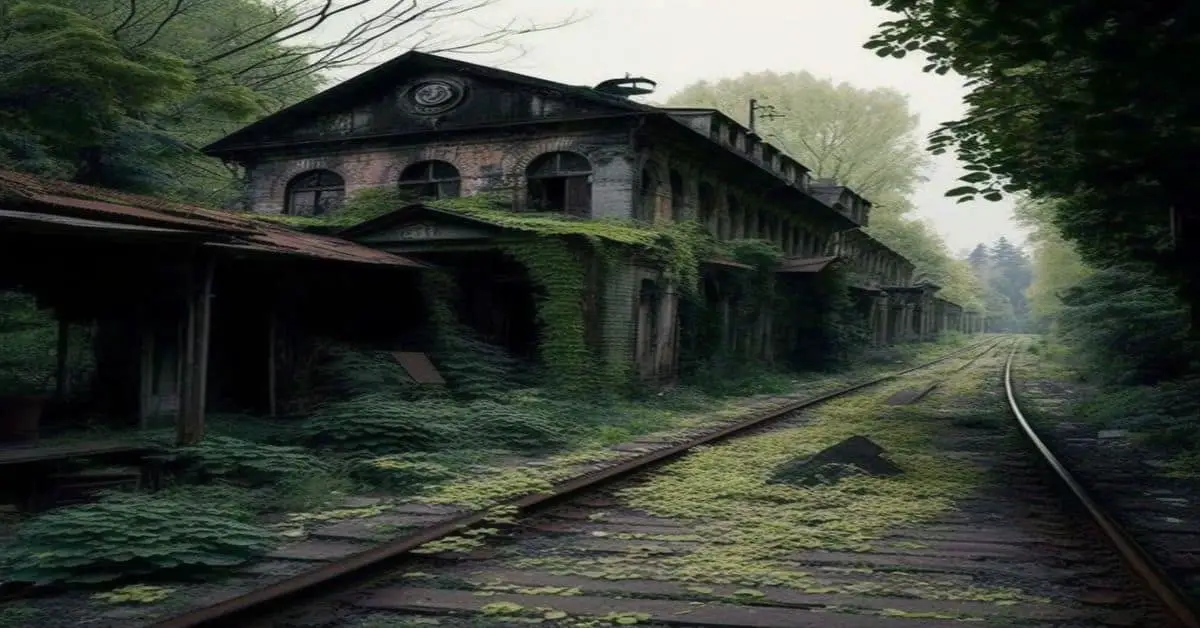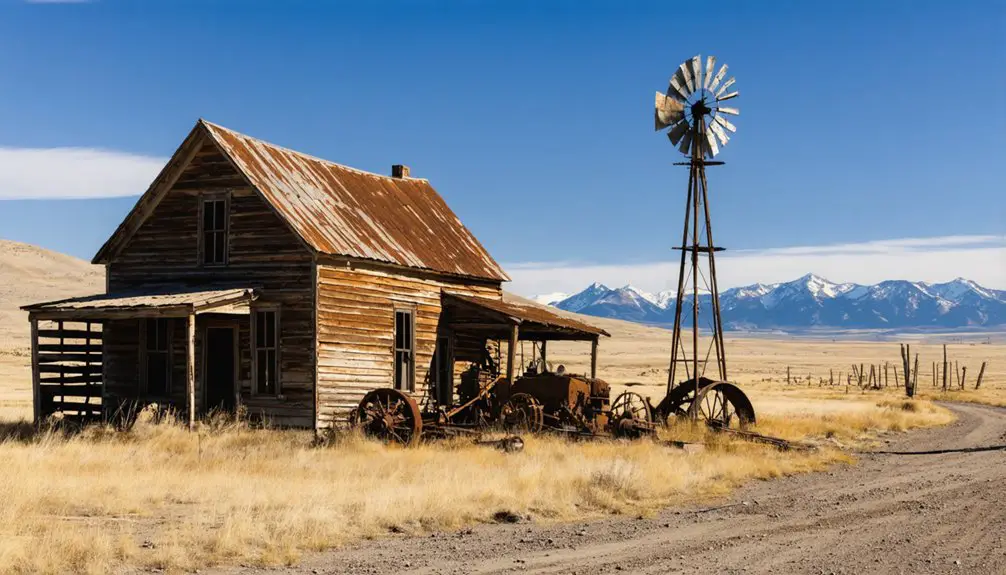You’ll discover Moskee, Wyoming‘s remains tucked away in the Black Hills, where the McLaughlin Tie & Timber Company launched America’s first federal timber sale in 1899. The company town later thrived under Homestake Mining Company‘s management, reaching 200 residents in the 1930s. Today, you can explore weathered buildings, a wooden water tower, and scattered railroad remnants that tell the story of this once-prosperous lumber community. The challenging 4-mile trek reveals hidden historical treasures.
Key Takeaways
- Moskee was established as a lumber town by McLaughlin Tie & Timber Company and gained historical significance with America’s first federal timber sale in 1899.
- The town reached its peak population of 200 residents during the 1930s when operated by Homestake Mining Company.
- As a company town, Moskee provided housing, essential services, and schooling to workers while operating under Homestake Mining Company’s control.
- The wooden water tower, featuring weathered sides and broken windows, stands as a prominent reminder of the town’s industrial past.
- The abandoned town requires a 4-mile trek to explore its scattered remnants, including railroad artifacts and timber foundations.
The Rise of a Lumber Empire
While many Wyoming towns sprang up around mining operations in the early 1900s, Moskee’s destiny was tied to the lumber industry through the McLaughlin Tie & Timber Company‘s initial founding. The area’s rich timber heritage dates back to when the first federal sale of timber in U.S. history occurred here in 1899.
You’ll find that early operations ceased in 1907, but the town’s timber legacy took a dramatic turn in 1921 when Homestake Mining Company breathed new life into the community. They’d transform Moskee into a specialized timber supplier for mining operations.
The lumber boom reached its peak in the 1930s when the population swelled to 200 residents, all supported by the bustling sawmill and timber operations. The town’s growth led to the establishment of a post office in 1925.
This prosperity wouldn’t last forever though – World War II forced the mill’s closure, and despite the region’s rich timber resources, Moskee’s once-thriving lumber empire never recovered.
Life in a Company Town
As a company town controlled by Homestake Mining Company, Moskee operated under a rigid structure where every aspect of daily life centered around the sawmill’s operations.
The company’s control extended beyond employment, providing housing and essential services to its workers. Similar to first train arrival in Buffalo in 1918, the arrival of rail transportation proved transformative for the community. You’d find community dynamics shaped by isolation and shared industrial purpose, with social life revolving around work schedules and occasional company-sponsored gatherings. Like many historic Black Hills communities, the town’s identity was deeply rooted in its industrial purpose.
Life in Moskee meant complete dependence on the company, from your home to your social circle and daily routines.
- Your housing assignment depended on your role at the mill
- You’d rely on the company post office opened in 1925 for all communication
- Your children would attend the town’s only school, established in 1928
- Your livelihood remained entirely tied to the company’s success or failure
The town’s peak population of 200 in the 1930s reflected a tight-knit community where survival and work intertwined.
Water Tower Legacy
Standing atop a hill south of Moskee’s remnants, the town’s wooden water tower tells a compelling story of life in this former company town.
You’ll find this two-story structure served as the critical water supply for residents and fire hydrants, with its elevated redwood tank using gravity to distribute water throughout the community.
Today, you can observe the tower’s weathered wooden sides and broken windows, evidence of time’s relentless march.
Like its Oregon counterpart, the structure has become a refuge for wildlife, particularly mice and squirrels seeking shelter.
While no longer functional, it stands as a rare surviving monument to an era when small company towns maintained their own utilities.
The decline of Moskee was directly linked to the opening of Homestake Forest Products in Spearfish.
Historical preservation efforts face significant challenges, from rot remediation to structural stabilization.
The tower’s potential adaptive reuses could include conversion to temporary housing or development as a heritage tourism site.
Hidden Relics and Railroad Remnants
Deep within Moskee’s forested terrain, you’ll discover scattered remnants of its once-bustling railroad and lumber operations from the early 1900s.
These hidden artifacts tell the story of McLaughlin Tie & Timber Company‘s development and Homestake Mining Company‘s revival of the town in 1921. The town’s prosperity peaked during the mining boom era of the 1920s and 1930s. Like the historic charcoal kilns of Piedmont, these industrial remains provide insight into Wyoming’s early resource extraction history.
Today, you’ll need to venture on a challenging 4-mile trek to explore these historical treasures.
Pack your hiking boots – this rugged 4-mile journey into history demands determination to discover its hidden treasures.
- Weathered timber foundations reveal early 20th-century construction techniques used in mill buildings
- Railroad artifacts and overgrown rail lines showcase the town’s essential transportation infrastructure
- Charred wooden planks and scattered building materials document the site’s industrial past
- Original fire hydrants stand as silent sentinels, once protecting the wooden structures that dominated the landscape
The remote location has both preserved and endangered these relics, with limited conservation efforts to protect them from nature’s steady reclamation.
The Final Days of Prosperity
While Moskee reached its peak population of nearly 200 residents in the 1930s, the town’s prosperity wouldn’t last beyond World War II. You’d have found a bustling lumber town supplying timber to the Homestake Mining Company, with a post office and schoolhouse serving as crucial community centers.
The sawmill operations drove the local economy, providing essential materials for mining infrastructure throughout the region. Like South Pass City’s exaggerated gold claims, the promise of lucrative timber contracts drew many hopeful workers to the area. Similar to the Piedmont kilns, the timber industry required skilled laborers to process raw materials for industrial use.
But wartime pressures brought economic hardship, forcing the mill to shut down. When railroad routes shifted and mining demand declined, Moskee’s isolation sealed its fate.
You would’ve witnessed a rapid community decline as families departed, businesses closed, and the post office shuttered. The once-vibrant timber town transformed into a ghost town, its buildings standing as silent witnesses to an era of resource-driven prosperity.
Frequently Asked Questions
Are There Any Reported Ghost Sightings or Paranormal Activities in Moskee?
You won’t find documented ghost stories or paranormal investigations here. Historical records show no verified supernatural activity, and researchers haven’t uncovered any credible reports of ghostly encounters in the area.
What Natural Wildlife and Plant Species Can Visitors Expect to Encounter?
While hiking, you’ll spot abundant mule deer grazing near ponderosa pines. You can discover rich wildlife diversity including elk, black bears, and golden eagles, alongside native plants like lupine and serviceberry throughout the area.
Is Camping or Overnight Stays Permitted Near the Ghost Town?
You can’t camp directly at the site due to private property restrictions. For overnight accommodations, you’ll need to follow camping regulations on nearby public lands, staying at least outside property boundaries.
What Are the Best Seasons and Weather Conditions for Visiting?
You’ll find the best time to visit is late summer through early September when weather patterns are mild and stable, with warm days, cool nights, and clear skies for exploring.
Are Metal Detectors or Artifact Collection Allowed on the Property?
You’ll face a million regulations against metal detecting – it’s absolutely forbidden without specific permission. Wyoming’s strict artifact preservation guidelines protect historical sites, and you must obtain proper authorization before collecting anything.
References
- https://www.ghosttowns.com/states/wy/moskee.html
- https://snowgoer.com/snowmobile-trips/ghost-towns/3070/
- https://www.sdpb.org/rural-life-and-history/2023-08-21/some-black-hills-ghost-towns-and-their-origins
- https://mycountry955.com/photos-show-what-halloween-was-like-in-wyoming-100-years-ago/
- https://travelwyoming.com/blog/stories/post/5-wyoming-ghost-towns-you-need-to-explore/
- https://jacksonholehistory.org/wp-content/uploads/chronicle-june-2022-FINAL-web-sawmills.pdf
- https://wyofile.com/wyo-loggers-fear-extinction-as-federal-forest-policy-evolves/
- https://cowboystatedaily.com/2025/08/04/shift-in-timber-rules-could-clear-way-for-revival-of-wyomings-lumber-industry/
- https://www.fs.usda.gov/rm/pubs_series/rmrs/rb/rmrs_rb033.pdf
- https://sites.rootsweb.com/~wytttp/history/bartlett/chapter33.htm



